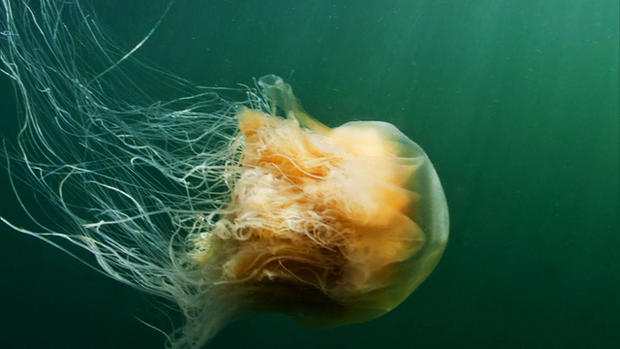Jellyfish: Beautiful, dangerous, delicious
Summer is a congenial time to take a dip in the ocean, unless that is, you encounter one of the creatures Martha Teichner has to show us:
There's something out there in the water, just waiting to get you.
No, not a shark -- a whole lot more likely, a jellyfish.
An estimated 150 million people are stung by jellyfish every year around the world, according to a paper published by the Journal of Travel Medicine. The stings are anywhere from just irritating to deadly.
Endurance swimmer Diana Nyad was stung repeatedly by the venomous box jellyfish during her attempts to swim from Cuba to Florida.
Another type of box jelly, called the irukandji, from Australia, is the size of your thumbnail. If he stings you, you've had it.
"I've heard it described as, if it doesn't kill you, you want to die, it's so excruciatingly painful, and it lasts for 10, 12, 15 hours," said Mark Shick, a collection manager at the Shedd Aquarium in Chicago.
Is there any antidote? No.
But Shick says, "Jellies don't want to sting us. They don't actively hunt people. They're just floating around, doing their thing, trying to catch food, and you just have to bump into one. So I think they're misunderstood.
And, he added, "They're quite beautiful."
Since it opened in 2011, the "Jellies" exhibit at the Shedd Aquarium has been seen by two million or so people a year, it's that popular.
Why "jellies," not jellyfish? Because they aren't actually fish.
So what are they? "They're a little bag of water that swims around, [is] the way to think of them."
Something like 97 percent water. They have no bones, and most, no brain or eyes. They've existed for at least 500 million years, and are found at every depth and temperature throughout the oceans. There's even a lake thick with them, in the Pacific Island country of Palau.
With all but a few varieties, the stingers are on their tentacles.
"On those tentacles they have what's called a nematocyst," said Shick, "Basically, it's kind of like a harpoon, very microscopic harpoon that's under pressure, and when it hits something, a little hair-trigger fires it off and it injects into whatever it hits."
An adult jelly (male or female) is called a medusa. But it starts life as an egg, which hatches into a hairy-looking larvae, which in turn attaches to something, and then becomes a microscopic polyp.
Polyps can multiply; when conditions are right, they start throwing off lots of babies.
"The top part is the bell," said Shick, describing a moon jelly, "and underneath they have the mouth, and you can see these really fine little filaments hanging out are tentacles where they would sting."
There are hundreds of varieties of jellies, in all shapes and sizes. Lion's Mane Jellies can grow to over 80 feet long.
And then there are Nomura's Jellies, as big as refrigerators at times. In 2009, there were so many in the Sea of Japan, they devastated the local fishing industry, and even capsized a fishing boat.
All those Nomura's Jellies are Exhibit A for a vocal group of researchers delivering a scary message, amplified by media coverage, that jellies are turning the seas into a giant, gelatinous soup -- the result of overfishing, pollution, climate change, even radiation.
They list dozens of incidents, like one in Israel in 2011, where tons of jellyfish clogged water intakes and shut down major power plants, as proof.
However, oceanographer Rob Condon, an assistant professor at the University of North Carolina-Wilmington's School of Marine Biology, says cries of an upcoming cataclysm are not true, based on the data.
"What you're doing is you're creating myth, and you're completely deviating from the whole scientific method and the whole scientific process."
Condon heads a worldwide study group doing the science, testing the effects of rising water temperatures and acidity on jellies, tracking their numbers over time.
Jellyfish populations rise and fall in roughly 20-year cycles, he says, and it's way too early to tell whether anything abnormal is actually happening.
"Jellyfish are not bad," said Condon. "The doom-and-gloom thing is overplayed. They're an integral part of marine and oceanic systems."
In Asia, people even eat them -- chopped up, turned into a salad. Some of the best ones come from coastal Georgia -- fat, squishy jellyballs.
Processor Golden Island International just ended its best season ever, shipping nearly 3 million pounds to China and Japan.
You might ask, aren't the tentacles toxic? No, not once the slime's been washed off.
But, if you should ever get stung, here's some advice from the experts: Douse the sting with vinegar. Peeing on it, an old wives' tale, doesn't work.
And another thing: More than nine million people may have seen this stunt on YouTube (left). Don't try it.
For more info:

